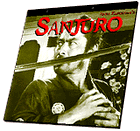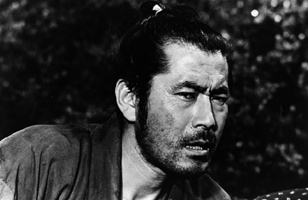

Japan action
1962
bw 96 min.
Director: Akira Kurosawa
CLV: $49.95 - available
1 disc, catalog # CC1370L
VHS: available from Home Vision Cinema

In the Kurosawa movie family tree, Sanjuro (1962) is the
sassy kid brother to Yojimbo, and like many light-hearted
younger siblings, it's underrated. After Yojimbo achieved
blockbuster status in 1961, Kurosawa took a story he'd already
developed about a semi-strong but wily swordsman and turned it into
another vehicle for Toshiro Mifune's shrewd, grungy, and
superbly-skilled warrior. Even his sobriquet becomes a running
joke. In both movies, Mifune says that he's called Sanjuro, which
means "30 years old," and quips, "going on 40." He
then tacks on a name inspired by the nearest vegetation: In
Yojimbo, he's Sanjuro "Kuwabatake" ("mulberry
field"); in Sanjuro, he's Sanjuro "Tsubaki"
("camellia").
Of course, Mifune writes his true signature in
blood. Indeed, Sanjuro has a final spurt that tops anything in
the original for gut-wrenching shock. Why, then, is this film so much
sunnier? Partly because Sanjuro, a classical work, sees its
anti-hero from the outside, as a one-of-a-kind figure combining
contemporary disillusionment and mythic prowess, while Yojimbo
(ultimately the more daring movie) takes us inside the sadomasochistic
psychology of a man of action. And in one crucial way, Sanjuro
plays like a frolicsome prequel. Here, feudalism isn't dead and its
followers have some virtues--unlike the gamblers, merchants, and
ex-cons of Yojimbo. If Sanjuro lacks the savage
intensity of Yojimbo--and if, to borrow MAD magazine's
old slogan, it doesn't have quite the degree of "humor in a
jugular vein"--it does possess compelling sweep, a guttural charm,
and an encompassing irony that transforms the swordsman's bluster into
a form of domestic comedy. In Yojimbo, he's the perfect man to
clean up a town filled with homicidal grotesques (by killing off just
about everyone). In Sanjuro, he's a Japanese bull in a china
shop.
As with other second movies in escapist series--from The
Adventures of Sherlock Holmes to From Russia With
Love--Sanjuro has a pleasurable aplomb. Mifune enters the
action--and a clan samurai meeting--abruptly and confidently, without
knocking. He's overheard the youthful samurai discuss a supposedly
corrupt clan chamberlain and a supposedly sympathetic superintendent.
Sanjuro can tell that the young blades are well-meaning fools--the
superintendent is evil, the chamberlain righteous. But he aligns
himself with these idealists and saves their lives.
From the first
swordfight, when Sanjuro puts himself between the superintendent's men
and the samurai (he hides them under the floorboards), Kurosawa's
compositions make a letterboxed transfer indispensable. Sanjuro cuts
through massed enemies like a human sickle, but his attack loses its
abstract, circular beauty on the usual home-video prints, which hurl
you into the center of the mayhem. Back in 1961, in a review of the
1958 adventure The Hidden Fortress, Dwight Macdonald accused
Kurosawa of "uncertainty" because in his movies, "behavior
is either very stiff, formalized, ceremonious--or just the
opposite. It corresponds to the modern history of Japan: a clash
between a feudal and a modern style of life in which the elements have
not been synthesized into the middle-class pattern that the West has
evolved over centuries, but continue to exist side by side."
Macdonald was right about everything except the uncertain part. In
Sanjuro, Kurosawa's visual strategy is built on the contrast
between the feudal ingenues and the modern profile of his freelance
fighter. They seat themselves in geometric patterns or line themselves
up in a straight row while he slumps and scratches himself and
dozes. (Mifune is magnificent--earthy and funny--not far removed from
John Belushi's parody of him on Saturday Night Live.)
Non-letterboxed video prints muddle the director's intentions as well
as his compositions.
Kurosawa revives the first definition of irony:
"the use of words to convey the opposite of their literal
meaning." As a one-time foe observes, Sanjuro often insults when
he means to praise. The cinematic wrinkle here is that Kurosawa
achieves irony in both words and images. The samurai mistake the
chamberlain for a villain because they think he's ugly. Some of them
mistrust Sanjuro himself because, unlike a proper samurai, he asks for
food and money. The chamberlain's wife seems soft and homiletic when
she describes Sanjuro as an unsheathed sword, poised to strike at any
time (even when it isn't necessary); actually, she has his number. His
final showdown demonstrates the horror of his business for all to
comprehend. But Kurosawa's eye makes the combat beautiful, just as his
dramatic instinct makes it magnetic. Sanjuro is
inspirational. That's the crowning irony.
--Michael Sragow
CREDITS
Directed by: Akira Kurosawa
Produced by: Tomoyuki Tanaka,
Ryuzo Kikushima
Screenplay by: Ryuzo Kikushima, Hideo Ogumi, Akira
Kurosawa
Photographed by: Fukuzo Koizumi, Takao Saito
Art director: Yoshiro
Muraki
Music by: Masaru Sato
TRANSFER
This edition proudly presents Sanjuro in its
original theatrical aspect ratio of 2.35:1.





